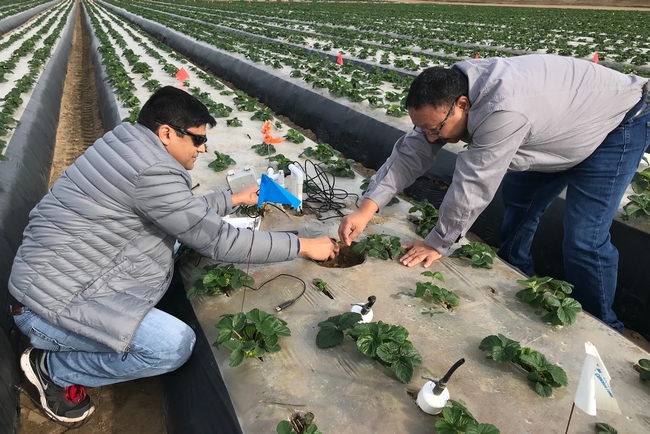Water is among the most precious resources on the planet. Some areas don't get enough; some get too much. And climate change is driving both of those circumstances to ever-growing extremes.
Two UC Merced experts in civil and environmental engineering took part in a recent report by the Environmental Defense Fund examining the issue and potential solutions. Associate Professor of Extension Tapan Pathak and Professor Josué Medellín-Azuara co-authored the report, "Scarcity and Excess: Tackling Water-Related Risks to Agriculture in the United States," and wrote the section pertaining to California.
In addition to climate change, disruptive human interventions such as groundwater over-extraction, sprawling drainage networks and misaligned governance are driving up water-related agricultural costs, particularly in midwestern and western states, the researchers found.
The problem is magnified in California, which hosts the largest and the most diverse agricultural landscape in the U.S., Pathak and Medellín-Azuara wrote, with gross revenues from farms and ranches exceeding $50 billion.
"Due to the favorable Mediterranean climate, unique regional microclimate zones, a highly engineered and developed water supply system, and a close connection between producers and research and cooperative extension institutions, California's agricultural abundance includes more than 400 commodities, some of which are produced nowhere else in the nation," the UC Merced researchers wrote.
But the state's varying climate and water needs pose a challenge. Though most of the precipitation falls in the northern part of California, the southern two-thirds of the state account for 85% of its water demand. And all of those crops must be watered in the summer, when there is little, if any, rainfall.
Some of the water comes from snowpack developed through winter storms and stored in reservoirs as it melts. Much of it comes from the Colorado River.
"Substantially less water is captured and stored during periods of drought, imperiling California's water supply and putting agricultural water needs at risk," Pathak and Medellín-Azuara wrote.
Climate change, with increasing periods of drought between excessively wet winters, magnifies that risk.
"Further, the rate of increases in the minimum temperatures in the Sierra Nevada is almost three-fold faster than maximum temperatures, resulting in potential decrease in the snowpack, earlier snowmelt, and more water in liquid form as opposed to snow," the researchers wrote. "According to the California Department of Water Resources, by 2100, the Sierra Nevada snowpack is projected to experience a 48% to 65% decline from the historical average."
Climate change is also expected to affect the availability of water from the Colorado River.
Climate extremes such as heat waves, drought and flooding - giving rises to increased weeds, pests and disease - are already significantly impacting agriculture and the broader economy, Pathak and Medellín-Azuara wrote.
The state's drought from 2012 to 2016 led to about 540,000 acres of fallow farmland in 2015, costing the state's economy $2.7 billion in gross revenue and 21,000 jobs. With the lack of precipitation, farmers increasingly pumped groundwater to irrigate crops, depleting those resources.
The report goes on to recommend policies, programs and tools be developed for agricultural resilience, including:
- Changing land use and crop management practices to support a transition to an agriculture footprint that can be sustained by the available water supplies.
- Increasing farmer and water manager access to important data and innovative technological tools to support their efforts.
- Reimagining built infrastructure and better using natural infrastructure so regions are better equipped to handle weather extremes.
- Developing policy and funding mechanisms to support mitigation and adaptation to water-related risks, avoid maladaptation and ensure food and water security.
"California's innovative agriculture needs to rapidly adapt to more volatile water availability, climate-driven higher water demands, and regulation protecting groundwater reserves, communities and ecosystems," Medellín-Azuara said. "The early adoption of more sustainable practices in agriculture will likely pay off dividends both in the short and long terms."
Added Pathak, "California faces significant challenges related to climate change, but it also presents opportunities for innovations, collaborations and sustained growth. To make agriculture resilient to climate risks, we need to engage in holistic solutions that integrates environmental, social, economic and policy considerations."

